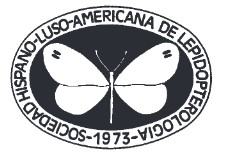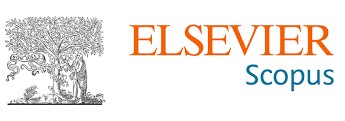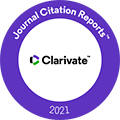Variation in hindwing size and shape of Plutella xylostella (Linnaeus, 1758) (Lepidoptera: Plutellidae)
DOI:
https://doi.org/10.57065/shilap.338Keywords:
Lepidoptera, Plutellidae, morfometría geométrica, insectos plaga, taxonomía, VenezuelaAbstract
Plutella xylostella (Linnaeus, 1758) has been claimed to be the most widely distributed Lepidoptera species. However, it is a highly polymorphic species, and there is evidence that what is known as P. xylostella is a species group, so it is possible that all records do not correspond to this species. Aim of the work was to evaluate the variability of hindwing size and shape of Venezuelan P. xylostella specimens and explore possible differentiation between groups of individuals. For this purpose, 126 specimens belonging to the entomological collections of the Museo del Instituto de Zoología Agrícola Francisco Fernández Yépez (MIZA, Central University of Venezuela) and the Instituto Nacional de Investigaciones Agrícolas (INIA), were sampled. Variation patterns of wing size and shape were studied by means of landmark-based geometric morphometrics. The analysis revealed significant differences in wing shape between three groups separated by differences observed in the bifurcation of the M vein. These differences may be due to intra- or interspecific variation; there is not enough evidence to discern. In Venezuela, there are three morphotypes of P. xylostella, separated based on differences in shape and size of their hindwings. It is important to clarify the identity of these morphotypes by combining these results with further information such as molecular data and immature morphological taxonomy.
Downloads
Global Statistics ℹ️
|
375
Views
|
323
Downloads
|
|
698
Total
|
|
References
ADAMS, D., COLLYER, M. L. & KALIONTZOPOULOU, A., 2018.– Geomorph: Software for geometric morphometric analyses.– R package version 3.0.6.
ANDERSON, M. J., 2001.– A new method for non-parametric multivariate analysis of variance.– Austral Ecology, 26(1): 32-46. DOI: https://doi.org/10.1111/j.1442-9993.2001.01070.pp.x
BAI, Y., BIN MA, L., XU, S. & WANG, G., 2015.– A geometric morphometric study of the wing shapes of Pieris rapae (Lepidoptera: Pieridae) from the Qinling Mountains and adjacent regions: An environmental and distance-based consideration.– Florida Entomologist, 98(1): 163-169. DOI: https://doi.org/10.1653/024.098.0128
BARANIAK, E., 2007.– Taxonomic revision of the genus Plutella Schrank, 1802 (Lepidoptera: Plutellidae) from the Palaearctic region with notes on its phylogeny.– Polskie Pismo Entomologiczne, 76 (Supplement): 1-122.
BECHYNÉ, J. & BECHYNÉ, B., 1970.– Consideraciones sobre la Ley de Maulik (Coleoptera: Phytophaga).– Actas IV Congreso Latinoamericano de Zoología pp. 669-682.
BOOKSTEIN, F. 1991.– Morphometric tools for landmark data: Geometry and Biology: 435 pp. Cambridge University Press, Cambridge. DOI: https://doi.org/10.1017/CBO9780511573064
CAÑAS-HOYOS, N., MÁRQUEZ, E. J. & SALDAMANDO-BENJUMEA, C. I., 2014.– Differentiation of Spodoptera frugiperda (Lepidoptera: Noctuidae) corn and rice strains from Central Colombia: a wing morphometric approach.– Annals of the Entomological Society of America, 107(3): 575-581. DOI: https://doi.org/10.1603/AN12154
CHACKO, J. & NARAYANASAMY, P., 2002.– Morphological characteristics of five diamondback moth (Plutella xylostella L.) populations.– In A. A. KIRK & D. BORDAT (eds.). Improving biocontrol of Plutella xylostella: pp. 147-152. Proceedings of the International Symposium. Montpellier, France, 21-24 October 2002. CIRAD, USDA-ARS. CIRAD, Montpellier.
COLLYER, M. L., SEKORA, D. J. & ADAMS, D. C., 2015.– A method for analysis of phenotypic change for phenotypes described by high dimensional data.– Heredity, 115(4): 357-365. DOI: https://doi.org/10.1038/hdy.2014.75
FERREIRA, W., 2014.– Padrões de variação morfológica nas asas de Sphingidae (Lepidoptera: Bombycoidea): efeitos alométricos, filogenéticos e dimorfismo sexual: 67 pp. [Master Dissertation] University of Brasilia, Brasilia.
FRANCOY, T. M., WITTMANN, D., DRAUSCHKE, M., MÜLLER, S., STEINHAGE, V., BEZERRA-LAURE, M., DE JONG, D. & GONÇALVES, L. S., 2008.– Identification of Africanized honey bees through wing morphometrics: two fast and efficient procedures.– Apidologie, 39(5): 488-494. DOI: https://doi.org/10.1051/apido:2008028
FRANCOY, T. M., WITTMANN, D., STEINHAGE, V., DRAUSCHKE, M., MÜLLER, S., CUNHA, D. R., NASCIMIENTO, A. M., FIGUEIREDO, V. L. C., SIMÕES, Z. L .P., DE JONG, D., ARIAS, M. C. & GONÇALVES, L. S., 2009.– Morphometric and genetic changes in a population of Apis mellifera after 34 years of Africanization.– Genetics and Molecular Research, 8(2): 709-717. DOI: https://doi.org/10.4238/vol8-2kerr019
FRANCOY, T. M., GRASSI, M. L., IMPERATRIZ-FONSECA, V. L., MAY-ITZÁ, W. & QUEZADA-EUÁN, J. J., 2011.– Geometric morphometrics of the wing as a tool for assigning genetic lineages and geographic origin to Melipona beecheii (Hymenoptera: Meliponini).– Apidologie, 42(4): 499-507. DOI: https://doi.org/10.1007/s13592-011-0013-0
JANSSEN, K., REINEKE, A. SHEIRS, J. A., ZEBITZ, C. P. W. & HECKEL, D. G., 2008.– A host shift of diamondback moth from crucifers to peas: life history traits and genetic mechanisms.– In A. M. SHELTON, H. L. COLLINS & Y. ZHANG (eds.). The management of Diamondback Moth and other crucifer pest: Proceedings of the 5th International Workshop, Beijing 2006: pp. 55-62. Agricultural Science and Technology Press, Beijing.
JERATTHITIKUL, E., YAGO, M. & HIKIDA, T., 2014.– Sexual dimorphism and intraspecific variation in wing size and shape of Tongeia fischeri (Lepidoptera: Lycaenidae).– Entomological Science, 17(3): 342-352. DOI: https://doi.org/10.1111/ens.12068
JURIC, I., SALZBURGER, W. & BALMER, O., 2017.– Spread and global population structure of the diamondback moth Plutella xylostella (Lepidoptera: Plutellidae) and its larval parasitoids Diadegma semiclausum and Diadegma fenestrale (Hymenoptera: Ichneumonidae) based on mtDNA.– Bulletin of Entomological Research, 107(2): 155-164. DOI: https://doi.org/10.1017/S0007485316000766
JUSTUS, K. A. & MITCHELL, B. K., 1999.– Reproductive morphology, copulation, and inter-populational variation in the diamondback moth, Plutella xylostella (L.) (Lepidoptera: Plutellidae).– International Journal of Insect Morphology and Embryology, 28(3): 233-246. DOI: https://doi.org/10.1016/S0020-7322(99)00027-6
KARIYAWASAN, T., 2018.– Taxonomy, distribution and pest status of Plutella species (Lepidoptera: Plutellidae) in Australia and New Zealand: 123 pp. [Master Dissertation] Queensland University of Technology, Queensland.
KHAGHANINIA, S., MOHAMMADI, S. A., SARAFRAZI, A. M., IRANINE, K. & ZAHIRI, R., 2011.– Geometric morphometrics study on geographic dimorphism of codling moth Cydia pomonella (Lepidoptera, Tortricidae) from north west of Iran.– Vestnik Zologii, 45(5): 20-28. DOI: https://doi.org/10.2478/v10058-011-0028-z
KHIABAN, N. G. M. Z., IRANI, K. H., HEJAZI, M. S., MOHAMMADI, S. A. & SOKHANDAN, N., 2010.– A geometric morphometric study of the host populations of the Pod Borer, Helicoverpa armigera (Hübner) (Lepidoptera: Noctuidae) in some parts of Iran.– Munis Entomology & Zoology, 5(1): 140-147.
LANDRY, J.F. & HEBERT, P., 2013.– Plutella australiana (Lepidoptera: Plutellidae), an overlooked diamondback moth revealed by DNA barcodes.– ZooKeys, 327: 43-63. DOI: https://doi.org/10.3897/zookeys.327.5831
MÁRQUEZ, E., JARAMILLO, O. N., GÓMEZ-PALACIO, A. & DUJARDIN, J. P., 2011.– Morphometric and molecular differentiation of a Rhodnius robustus-like form from R. robusts Larousse 1927 and R. prolixus Stal 1859 (Hemiptera: Reduviidae).– Acta Tropica, 120(1): 103-109. DOI: https://doi.org/10.1016/j.actatropica.2011.06.009
MARSTELLER, S., ADAMS, D. C., COLLYER, M. L. & CONDON, M., 2009.– Six cryptic species on a single species of host plant: morphometric evidence for possible reproductive character displacement.– Ecological Entomology, 34(1): 63-73. DOI: https://doi.org/10.1111/j.1365-2311.2008.01047.x
MOZZAFFARIAN, F., SARAFRAZI, A., NOURI, G, & ARIANA, A., 2007.– Morphological variation among Iranian populations of the Carob Moth, Ectomyelois ceratoniae (Zeller 1839) (Lepidoptera: Pyralidae).– Zoology in the Middle East, 41(1): 81-91. DOI: https://doi.org/10.1080/09397140.2007.10638230
PERRARD, A., BAYLAC, M., CARPENTER, J. M. & VILLEMANT, C., 2014.– Evolution of wing shape in hornets: why is the wing venation efficient to species identification?.-Journal of Evolutionary Biology, 27(12): 2665-2675. DOI: https://doi.org/10.1111/jeb.12523
PICHON, A., ARVANITAKIS, L., ROUX, O., KIRK, A., ALAUZET, C., BORDAT, D. & LEGAL, L., 2006.– Genetic differentiation among various populations of the diamondback moth Plutella xylostella (Lepidoptera: Yponomeutidae).– Bulletin of Entomological Research, 96(2): 137-144. DOI: https://doi.org/10.1079/BER2005409
PZRZYBYTOWICZ, L., PNIAK, M. & TOFILSKI, A., 2015.– Semiautomatic identification of European Corn Borer (Lepidoptera: Crambidae).– Journal of Economic Entomology, 190(1): 1-5. DOI: https://doi.org/10.1093/jee/tov300
R CORE TEAM, 2018.– R: A language and environment for statistical computing.– R Foundation for Statistical Computing, Vienna, Austria.– Available from https://www.R-project.org/.
ROBINSON, G. S. & SATTLER, K., 2001.– Plutella in the Hawaiian Islands: relatives and host-races of the diamondback moth (Lepidoptera: Plutellidae).– Bishop Museum Occasional Papers, 67: 1-27.
ROGGERO, A. & PASSERIN, P., 2005.– Geometric morphometric analysis of wings variation of two populations of Scythris obscurella species-group: geographic or interspecific differences? (Lepidoptera: Scythrididae).– SHILAP Revista de lepidopterología, 33(130): 101-112.
ROHLF, F. J. 2010.– Tpsdig Version 2.16.– Department of Ecology and Evolution, State University of New York at Stony Brook, New York.
ROUX, O., GEVREY, M., ARVANITAKIS, L., GERS, C., BORDAT, D. & LEGAL, L., 2007.– ISSR-PCR: Tool for discrimination and genetic structure analysis of Plutella xylostella populations native from different geographical areas.– Molecular Phylogenetics and Evolution, 43(1): 240-250. DOI: https://doi.org/10.1016/j.ympev.2006.09.017
SALINAS, P. J. 1986.– Studies on diamondback moth in Venezuela with reference to other Latinamerican countries.– In: Diamondback Moth Management. Proceedings of the First International Workshop: pp. 17-24. Tainan, Taiwan, 11-15 March, 1985. Shanhua, Taiwan: Asian Vegetable Research and Development Center.
SUBRAMANIAN, S. & LÖEHR, B., 2006.– Is the diamonback moth a polyphagous pest? Some thoughts about its host range expansion to pea.– In Management of Diamondback Moth and other crucifer insect pests: Proceedings of the Fifth International Workshop: pp. 63-71. Beijing, China.
SWIFT, M. L., 1997.– GraphPad prism, data analysis, and scientific graphing.– Journal of Chemical Information and Computer Sciences, 37(2): 411-412. DOI: https://doi.org/10.1021/ci960402j
TALEKAR, N. S. & SHELTON, A. M., 1993.– Biology, ecology and management of the Diamondback Moth.– Annual Reviews of Entomology, 38(1): 275–301. DOI: https://doi.org/10.1146/annurev.en.38.010193.001423
VILLEMANT, C., SIMBOLOTTI, G. & KENIS, M., 2007.– Discrimination of Eubazus (Hymenoptera, Braconidae) sibling species using geometric morphometrics analysis of wing venation.– Systematic Entomology, 32(4): 625-634. DOI: https://doi.org/10.1111/j.1365-3113.2007.00389.x
Published
How to Cite
Issue
Section
License
Copyright (c) 2020 A. Moreno, A. Viloria

This work is licensed under a Creative Commons Attribution 4.0 International License.
The author SS retains his trademark and patent rights to any process or procedure within the article.
The author retains the right to share, distribute, perform and publicly communicate the article published in SHILAP Revista de lepidopterología, with initial acknowledgement of its publication in SHILAP Revista de lepidopterología.
The author retains the right to make a subsequent publication of his work, from using the article to publishing it in a book, provided that he indicates its initial publication in SHILAP Revista de lepidopterología.
Each submission to SHILAP Revista de lepidopterología must be accompanied by an acceptance of copyright and acknowledgement of authorship. By accepting them, authors retain copyright of their work and agree that the article, if accepted for publication by SHILAP Revista de lepidopterología, will be licensed for use and distribution under a "Creative Commons Attribution 4.0 International" (CC BY 4.0) licence that allows third parties to share and adapt the content for any purpose giving appropriate credit to the original work.
You may read here the basic information and the legal text of the license. The indication of the CC BY 4.0 License must be expressly stated in this way when necessary.
As of 2022, the content of the print and digital version is licensed under a "Creative Commons Attribution 4.0 International License" (CC BY 4.0), licence that allows third parties to share and adapt the content for any purpose giving appropriate credit to the original work.
Previous content in the journal was published under a traditional copyright licence; however, the archive is available for free access.
When using the contents of SHILAP Revista de lepidopterología published before 2022, including figures, tables or any other material in printed or electronic format belong to the authors of the articles, the authors must obtain the permission of the copyright holder. Legal, financial and criminal liabilities in this respect belong to the author(s).
In application of the Principle of Priority of the International Code of Zoological Nomenclature, no other version than the one published by the publisher may be deposited in repositories, personal websites or similar.





























